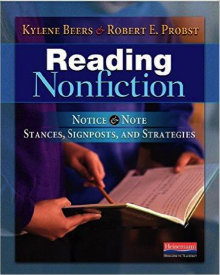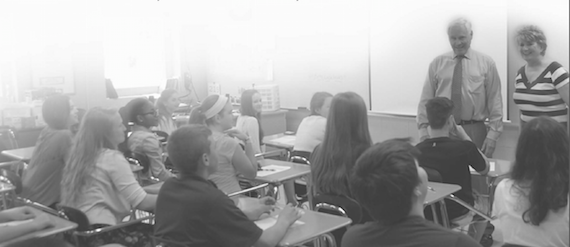Another Nonfiction Winner from Beers and Probst
Reading Nonfiction: Notice & Note Stances, Signposts, and Strategies
By Kylene Beers and Robert E. Probst
(Heinemann, 2015 – Learn more)

You are invited to a book party…
Get ready to be challenged, enlightened, and invigorated. Reading Nonfiction: Notice & Note Stances, Signposts, and Strategies is hitting the bookstores this week. Teachers who were enamored with Notice & Note: Strategies for Close Reading will fall in love again. (Or should I say “again and again.”)

One of the best resources I have seen to help us teach non-fiction reading strategies is this new book from Kylene Beers and Robert Probst. The authors have taken what they know about reading and used it to introduce strategies called Signposts, a reading routine that provides students with a better understanding of “what to look for” as they are reading.
Signposts provide a signal to students to slow down their reading and think. This leads to a much deeper understanding of the text and assists students in creating evidence-based responses as they continue to read.
Applying research and offering resources
The book is divided into four sections: Issues to Consider, The Importance of Stance, The Power of Signposts, and The Role of Strategies. I adore the way the book is constructed. Each chapter includes a conversation about the authors’ research, student examples, and a section with common questions teachers might ask. Kylene Beers and Robert Probst are about honesty and openness. They share their research successes, mistakes, retakes, and the steps they took to move forward.
When you are reading the book, the sidebars make you feel as if the authors are speaking directly to you. They also throw in a bit of humor, often at their own expense.
When one of their conversations with students began to go off topic – way off topic – and it was difficult to get the students back on topic, they admitted tongue in cheek that they were beginning to regret using real world examples in their lessons. The student conversations that are included in every chapter and with each strategy give you an opportunity to delve into the mind of students and understand their thinking.
Often when I am reading professional literature, I have those moments when I wonder, “Why didn’t I think of that?” “Why haven’t I been doing this? I used to.” Or, “I can’t wait to try what I have learned.” As I was reading this book, I couldn’t wait to go into the classroom and share the strategies with my students. They became my fourth grade confidants and cheerleaders. The excitement that I had for this book was contagious. I wanted to share it with everyone – colleagues, parents, and students.
Among the Signposts: the “Aha” moment
One of the Signposts in Notice & Note: Strategies for Close Reading is the “Aha” moment – the moment the character realizes or understands something that until that point, he had not known. It’s a realization that will likely change his or her actions in some way.
As I read Reading Nonfiction: Notice & Note Stances, Signposts, and Strategies I had many “Aha” moments. For example, when the authors introduced questioning techniques I sat back, pondered and then thought “Aha.” Now this makes sense. Why didn’t I think about it before? How can I change my instruction to apply this wonderful piece of teaching advice?
For example, students are asked to read with three questions in mind:
- What surprised me?
- What did the author think I already knew?
- What changed, challenged, or confirmed what I already knew?
As I applied this strategy with my fourth graders, I noticed a change in the students’ thinking. They were able to separate the important facts from interesting facts and take their thinking up a notch. They applied what they knew about the subject matter, but also started to question their sources and thinking. The strategies in the book give ownership, responsibility and self-reliance to the students. And they will work equally well with kids in grades 5-8.
Even if you are unfamiliar with the “Signposts” strategy, it’s easy to navigate the nonfiction signposts. The authors are generous with the resources that they provide. Each signpost has “Anchor Questions Progression” for teachers to apply from elementary to high school. For example, the anchor question for Numbers and Stats progresses from “What does this make me wonder about” in the elementary grades to specific questions in secondary science such as “What purpose do these numbers serve in this context? Do these numbers help prove a point?”
Making the ideas yours
This book is not for the faint at heart. It is not a book that can be digested in one sitting. Each of the 298 pages are noteworthy and important to read and reread. Beers and Probst state this eloquently and honestly: “It’s your book now. It’s you who will transform these inkblots on the page into meaningful practices for your students. You will take these ideas, make them yours, and in doing so will make them better.”
Think about it. They are giving us their greatest gift – their knowledge and expertise. As outstanding educators, they are giving us the “wings to fly,” acknowledging us as professionals.
Without further ado, I give you the Non Fiction Signposts described by the authors:
- Contrasts and Contradictions – when the author presents something that contrasts or contradicts what the reader is likely to know, think or have experienced, or shows a difference between two or more situations, events or perspectives
- Extreme or Absolute Language – author uses language that leaves no doubt about a situation or event that exaggerates or overstates a case.
- Numbers and Stats – author uses number or words that show amounts or statistical information to show comparisons in order to prove a point or help create an image
- Quoted Words – author quotes others, directly, with what we call a Voice of Authority or Personal Perspective, or citing Others’ Words
- Word Gaps – author uses words or phrases students recognize they don’t know
(Download the introductions to all four parts of the book here.)
Reading Nonfiction: Notice & Note Stances, Signposts, and Strategies is without a doubt the most easily applicable professional reading I have ever encountered. For those teachers who have been anxiously waiting for the book to be published, it is well worth the wait. For all those Tweeters out there, get ready to tweet (@HeinemanPub) your thoughts, ideas, and success stories. For those Notice and Note Facebook fans, I can’t wait to read your posts. To Kylene and Bob, how can we begin to thank you?
Linda Biondi is a fourth grade teacher at Pond Road Middle School in Robbinsville, NJ, and a long-time Morning Meeting practitioner. She’s also the recipient of several educational grants, a Teacher Consultant with the National Writing Project and a participant on the NJ Department of Education Teacher Advisory Panel. Linda participates in ECET2 Celebrate Teaching which has posted an interview with her.



































It really helped me a lots thanks very much
Right On, Linda! This book is awesome! I have found myself going back again and again (no pun intended!) to get more out of what I read and reflect about how my students are using the stances, signposts, and strategies.
I am a fifth grade teacher and almost finished with this book. I can’t wait to use what I’ve learned in both this book and Notice and Note for fiction.